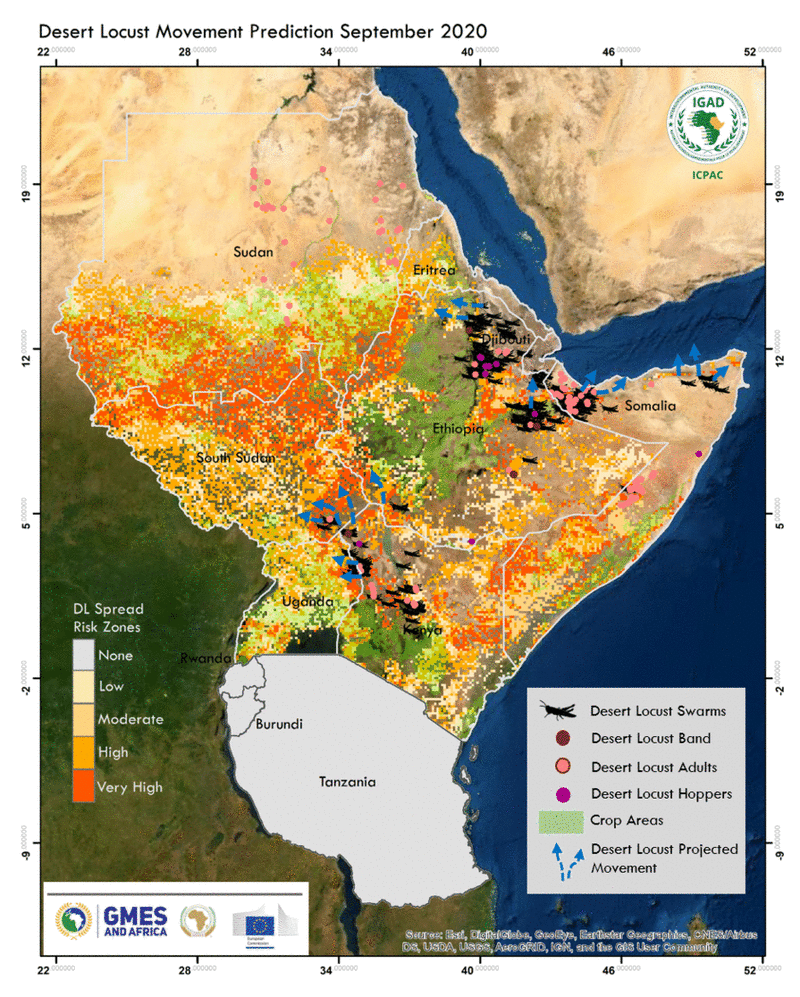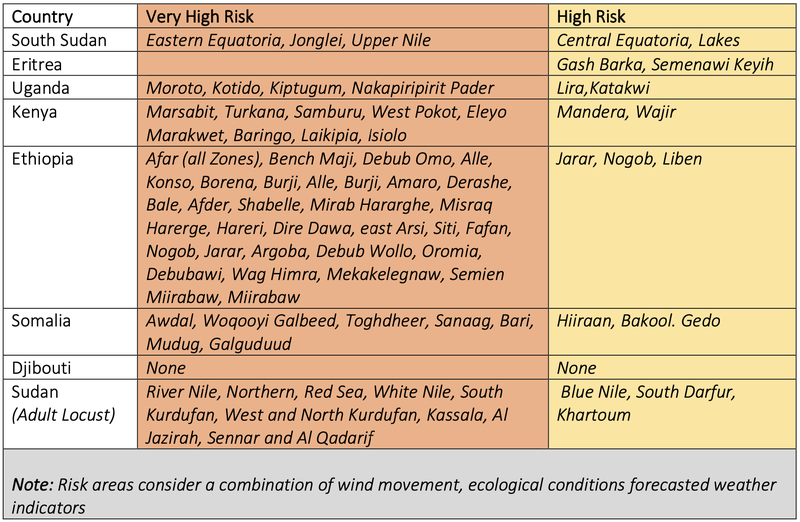Desert Locust Projection September 2020
Pastures and crop destruction continue to be reported mostly in Ethiopia and Somalia.

Projected impact on food and fodder production
- Pastures and crop destruction continue to be reported mostly in Ethiopia and Somalia.
- The risk of significant impact to both crops and rangelands is very high due to the sustained multiplying swarms and likelihood of swarms migrating. Most agro-pastoral areas in late vegetative and reproductive stages of crop development are at a high risk of potential damage to seasonal crops and regenerating pastures.
- Higher than usual rainfall in Sudan, northern Ethiopia and northern Somalia will continue to cause favourable conditions for locust to continue breeding and develop, increasing numbers of swarms if not effectively controlled.
- According to our recent seasonal forecast, a drier than usual season can be expected in most parts of Eastern Africa. This could reduce available vegetation for locusts, thereby reducing the number of swarms. Shifting wind directions later in the October, November and December season is likely to change the swarm’s movement southwards yet again, but against a backdrop of lesser vegetation available for multiplication.
Desert Locust spread
- In the current desert locust invasion areas of Eastern Africa, locust swarms have been reported in the last 6 weeks in northwestern Kenya, southern, northern and northeastern Ethiopia, northwest and northeastern Somalia. Adult locusts are also in large numbers in the areas where hoppers and bands were spotted in June which is in the trajectories of migrating swarms. There is large number of swarms despite the ongoing control efforts. Parts of Sudan continue to have adult locusts reported in Northern, River Nile and Red Sea states.
Forecasted climatic and ecological conditions
- Climatic conditions suitable for desert locust development are forecasted to be highly suitable in eastern Uganda, southern to eastern Sudan, northern Ethiopia, northeastern Somalia and northwestern Kenya.
- Ecological conditions (particularly the availability of green vegetation) are most suitable in the northern subregion due the current higher than usual rainfall received in the season which increased vegetation regrowth. This is a likely driver as to why the locust invasion is currently in high intensity in Afar, Debubawi, Dire Dawa (Ethiopia) and Hargeisa (Somalia).
- Wind direction and speeds, which greatly determine swarm movement is forecasted to be southerly and southwesterly in most parts of the region. Ethiopia has varying winds movement in the north which is likely to affect swarm locust movement to both eastwards in Dire Dawa and westwards in Afar. There is low risk for invasion for the southern and equatorial parts of the subregion and increased risk in northern countries of the region following the wind movement.
- Adult desert locust and swarms have been reported in Turkana, Samburu, West Pokot and Marsabit in Kenya. In Ethiopia in Debub Omo, Bale, Dire Dawa, Hareri, Misraq Harrge, Fafan, Siti, Debub Wollo, Debubawi, north Oromia and Afar (Zones 1-5). In Somalia adult locust and swarms have been reported in Awdal, Woqooyi Galbeed, Galguuduud, Mudug, Bari and Sanaag.
Desert locusts are projected to move from:
- Samburu areas of Kenya to Turkana and Marsabit
- Turkana areas and West Pokot areas of Kenya to Eastern Uganda areas of Moroto, Kotido, Pader and Kigum
- Eastern Equatorial areas of South Sudan to Jongoli and Upper Nile states
- South Ethiopia areas of Omo to Bench Maji, Agruak and Majang
- Ethiopia Afar and Debubawi regions to Misraqawi, Mehak Elegnaw, Semien Mirabaw and Wag Himra.
- North-eastern Ethiopia and northern Somalia and across the Red Sea to areas in Yemen.
- Intermittent multi-directional winds may favour swarms to move in varying directions during the projection period.
Highest risk areas for Desert Locust swarms and adult locust invasion based on forecasted climate conditions and existing vegetation conditions suitable for an invasion are outlined below:

REFERENCES
- Locust locations obtained from FAO Locust Hub: https://locust-hub-hqfao.hub.arcgis.com/. Data
downloaded 2 September 2020. - Greater Horn of Africa Climate Outlook Forum (GHACOF 56) Seasonal Predictions for the October November and December season.
